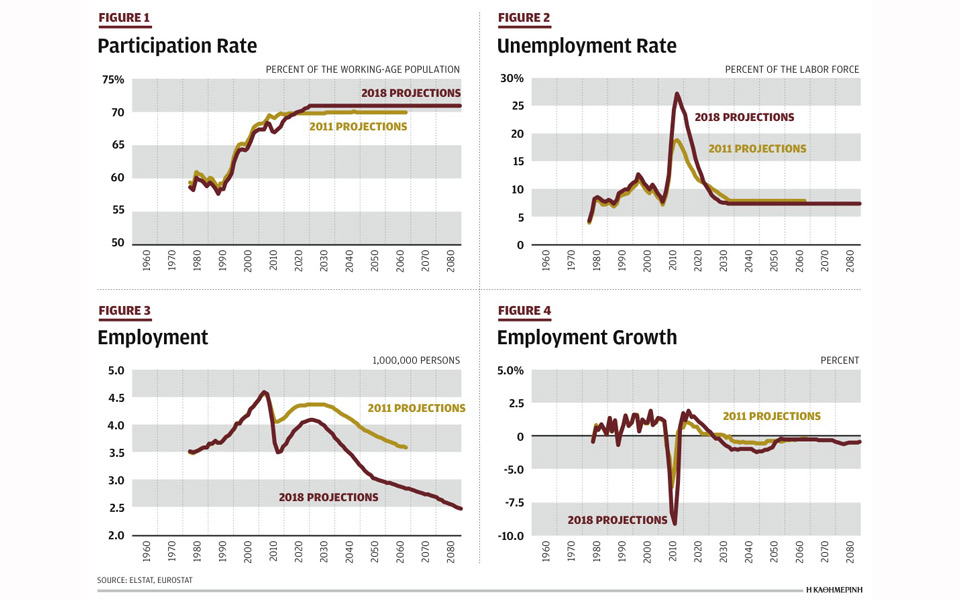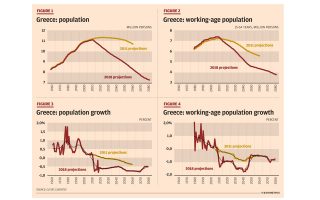Participation and unemployment consequences of the economic crisis

In a previous note, we discussed how the economic crisis of 2010-15 may have influenced long-term population and demographic developments in Greece. The arguments were guided by new data – updated projections through 2080 for population and the working-age population in Greece submitted by the Hellenic Statistical Authority (ELSTAT) to its European Union counterpart, Eurostat. The bottom line of the analysis was that the population and working-age population are now projected to decline faster and for longer than was anticipated in a projection obtained in 2011. The consequence of these downward revisions include that the Greek economy is likely to be smaller in the future than we thought before, and that the underlying, or potential, growth rate of the Greek economy may have been reduced over the projection period. This is a challenge for a country with high debt.
In this note, we dive another level deeper into these updated projections by analyzing the participation rate and the outlook for unemployment; we may then consider the possible path for employment following the crisis in the next Note of Discussion. These two notes combined will provide a more granular look into potential growth, and it will also suggest some policy areas that are of interest for the government in managing the challenges yet to unfold.
Participation. This term refers to persons in the 15-64 age group – i.e. in the working-age population (WAP) – who actively participate in the economy. The participation rate is then defined by the number of persons who participate divided by the working-age population. Not everyone may be able to participate. Those that are handicapped or enter into long-term sick leave are unlikely to work; a parent with a small child may drop out of the labor force temporarily or postpone entering the labor force until the child is older. And generous early retirement benefits provide incentives to quit the labor force early and lower participation.
The participation rate is important because if it drops, those that remain in the economy and continue to work have to care for more dependents that do not work. Conversely, a higher participation rate can generate a bigger economy, because a larger share of the working-age population is working. More people working in the economy provides a broader income tax base, it may generate economies of scale in production, and lower costs of providing government services. Thus, governments are interested in studying and monitoring the participation rate and need to think through the consequences of their policies in this regard.
Figure 1 on this page shows the participation rate for Greece that I used in a projection from 2011 and the rate that comes out of the current 2018 population data. The yellow line reflects projections from 2011 data and the solid line is from the 2018 data. The data show that the participation rate in Greece hovered around 60 percent of the working-age population in the 1980s and then began a steady rise in the 1990s-2000s as the Greek economy modernized and integrated deeper into the European Union. Participation rates of around 60-65 percent are now on the low side in international comparison and, depending on the definition used, a participation rate (PR) in the 70-75 percent of the WAP is more desirable (the eurozone has a PR of around 73 percent at present).
As the Figure shows, in the 2011 projection, it was assumed that the increase in participation would level off at around 70 percent in the future.
The new population data result in a participation rate that is slightly updated for the historical period, as shown in the solid line of Figure 1, and the increase in participation was interrupted by a decline in the early crisis years of 2010-12, but seems to be recovering in the most recent years again. This effect is often seen in a recession because some workers drop out of the labor force as they become discouraged by the difficulties of remaining employed or from being long-term unemployed. This “discouraged worker effect” is suggested in the Greek data because that would lower the participation rate. There are two reasons why the participation rate is now on the increase again. First, when the economy stabilizes, it is possible that more women and other family members of working age try to participate in the hope of offsetting some income/wage losses from the principle breadwinners. This “second-earner effect” is an income effect from the economic crisis. Second, it is possible that the discouraged worker effect has been an impetus for out-migration to other EU countries, and thus this effect is part of the explanation for the decline in population and WAP. If the number of persons in the country participating stabilizes, but the working-age population falls from out-migration, then the participation rate will go up for statistical reasons.
We will assume in the new projection that higher PR rate will continue and reach 71 percent. This rate is reasonably high for Greece and it gets more and more difficult to squeeze out even higher rates of participation as the full complement of working-age population is approached.
Labor force. In the data presented here, the number of persons that participate is defined as the “labor force.” And the labor force, in turn, comprises all persons who have a job – the employed – and those that are actively looking for a job – the unemployed. Thus, employment (E) + unemployment (U) = the labor force (LF), and the ratio of the labor force over the WAP is the participation rate in this note (statistical offices sometimes use a concept of “active labor force,” which can be slightly different from the “labor force” to calculate the participation rate).
We can now dig yet another level deeper and analyze what happened to unemployment in the past, and during the crisis, and make some sensible assumptions about how this variable may behave as the economy recovers into the future. Good policy-making is always based on quantified scenarios, so the government is well taken to monitor these data carefully, say, quarterly, and check the plans and the communications to the public as new findings come in and, perhaps, surprises show up on the radar screen. Investors and labor representatives also need to know these data for their own decision-making. Indeed, the government, employers’ organizations, and unions need to come together, based on the latest data and long-run projections, to have a tripartite dialogue on the best policy options to take the country’s economy forward. Data-based dialogue with sound underlying and open-minded analysis can contribute to higher-quality politics in any country.
Unemployment. Figure 2 shows the unemployment rate and projections with the 2011 and 2018 data, respectively.
What is interesting in the historical data is that unemployment in Greece has always been relatively high, around 8 percent of the labor force on average (I do not have consistent numbers prior to 1980). Even during the boom years prior to 2007, unemployment was high. This suggests that labor markets are not very competitive and that labor costs have been too high in Greece, and/or that incentives to compete in the labor markets were relatively low. It is therefore not surprising that respective programs have advocated labor market reforms and lower labor costs per unit of output to place labor in a better long-run competitive position.
What is also obvious is that the recession truly hit the economy hard. Workers suffered significant stress as re-equilibrating the labor markets in price or volume was proving to be no easy task. The price that the factor of production labor thus paid, in part, was a massive increase in unemployment – the economy could simply not reallocate resources fast enough to keep unemployment at bay. In the 2011 projections, given information present at that time, I expected the unemployment rate to peak just below 20 percent of the labor force. Even this dire forecast proved too optimistic as newer data reveal that unemployment peaked at 27.5 percent of the labor force.
To make the projections for the 2011 longer-run scenario, I assumed that unemployment would drop steadily in the 2020s and settle down at around its historical average of around 8 percent. In the revised and new projections, I assume that the unemployment rate will fall slightly faster than before, but from a higher starting level, and drop to 7.5 percent in a new equilibrium. The reason that somewhat lower unemployment must be possible is related to the effects of the recession, which produced lower labor costs that are assumed to linger in the future, hence making labor more competitive. Importantly, this scenario also assumes that the government does not reverse the labor reforms; instead there is good reason to deepen labor reforms to improve flexibility in the reallocation of labor (volume flexibility as contrasted with wage cuts).
It is important to note that the assumptions above are “objective driven” and are not a law of economics or nature. It is assumed that society wishes the unemployment rate to come down and that pressures for further progress in lowering unemployment will ease off around the longer-run unemployment rates mentioned above. There is no guarantee that these projections will turn out correct – what is being done here is to develop a narrative that would seem appropriately ambitious and could be accepted by society, if properly explained. The role for government is then to work with social partners (employers and unions) to monitor developments closely and agree on a set of policies that can correct the course if unemployment veers off in a higher direction, and that can guide the economy to deliver this result, at a minimum, over the longer run.
For example, one set of policies adopted in a tripartite agreement in the Netherlands in the 1980s, when this country went through a near-bankruptcy crisis, comprised a contribution from each social partner: Government agreed not to increase payroll taxes to fill holes in the budget; unions agreed to adopt long-run wage moderation for all professions to lower unit labor costs and improve competitiveness for the economy as a whole; and employers agreed to invest and protect employment and accept a broadening of part-time employment and other flexible employment arrangements, coupled with increased female labor participation, to assist employment. Even with these cooperative efforts, it took a whole decade before the Dutch economy was firing on all cylinders again. The ultimate success was that budget balance was restored, debt came down, and the external current account deficit was transformed into a surplus. This so-called “polder model” remains a cornerstone of Dutch competitiveness today.
Closing thoughts
In this note, I have decomposed the working-age population into the participating population and those who do not participate. In turn, participation shapes the size of the labor force, which comprises those who have a job and the unemployed.
Participation is important because a larger labor force can carry a bigger economy and that helps to resolve the burden of debt. Thus, government policy is interested in creating adequate participation. I assume in this note that the Greek participation rate will drift up to around 71 percent of the WAP, slightly below the eurozone average.
Once I have a projection for the size of the labor force, I can see what a reasonable future steady-state unemployment rate for Greece looks like. This, too, is subject to government policy, particularly labor market policy and wage moderation.
I advocate careful deliberation with social partners to work in tandem and keep participation as high as possible, and unemployment as low as possible.
In the follow-up Note for Discussion, I will derive what the above assumptions and projections mean for the crucial numbers on employment looking forward.
Bob Traa is an independent economist. This is the second in a series of articles by him for Kathimerini titled “Notes for Discussion – Essays on the Greek Macroeconomy.”





